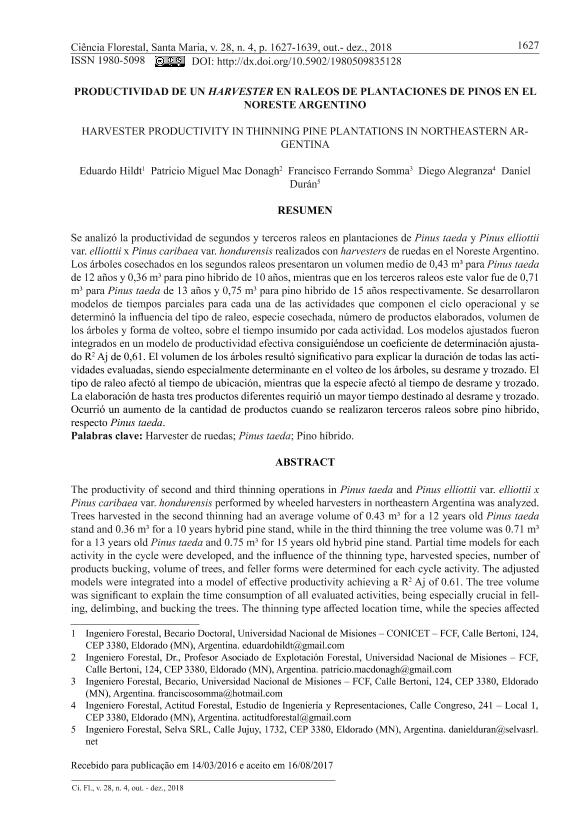Artículo
Se analizó la productividad de segundos y terceros raleos en plantaciones de Pinus taeda y Pinus elliottii var. elliottii x Pinus caribaea var. hondurensis realizados con harvesters de ruedas en el Noreste Argentino. Los árboles cosechados en los segundos raleos presentaron un volumen medio de 0,43 m3 para Pinus taeda de 12 años y 0,36 m3 para pino hibrido de 10 años, mientras que en los terceros raleos este valor fue de 0,71 m3 para Pinus taeda de 13 años y 0,75 m3 para pino hibrido de 15 años respectivamente. Se desarrollaron modelos de tiempos parciales para cada una de las actividades que componen el ciclo operacional y se determinó la influencia del tipo de raleo, especie cosechada, número de productos elaborados, volumen de los árboles y forma de volteo, sobre el tiempo insumido por cada actividad. Los modelos ajustados fueron integrados en un modelo de productividad efectiva consiguiéndose un coeficiente de determinación ajustado R2 Aj de 0,61. El volumen de los árboles resultó significativo para explicar la duración de todas las actividades evaluadas, siendo especialmente determinante en el volteo de los árboles, su desrame y trozado. El tipo de raleo afectó al tiempo de ubicación, mientras que la especie afectó al tiempo de desrame y trozado. La elaboración de hasta tres productos diferentes requirió un mayor tiempo destinado al desrame y trozado. Ocurrió un aumento de la cantidad de productos cuando se realizaron terceros raleos sobre pino hibrido, respecto Pinus taeda. The productivity of second and third thinning operations in Pinus taeda and Pinus elliottii var. elliottii x Pinus caribaea var. hondurensis performed by wheeled harvesters in northeastern Argentina was analyzed. Trees harvested in the second thinning had an average volume of 0.43 m3 for a 12 years old Pinus taeda stand and 0.36 m3 for a 10 years hybrid pine stand, while in the third thinning the tree volume was 0.71 m3 for a 13 years old Pinus taeda and 0.75 m3 for 15 years old hybrid pine stand. Partial time models for each activity in the cycle were developed, and the influence of the thinning type, harvested species, number of products bucking, volume of trees, and feller forms were determined for each cycle activity. The adjusted models were integrated into a model of effective productivity achieving a R2 Aj of 0.61. The tree volume was significant to explain the time consumption of all evaluated activities, being especially crucial in felling, delimbing, and bucking the trees. The thinning type affected location time, while the species affected delimbing and bucking time. When producing up to three assorted products, it was required more time for delimbing and bucking. There was an increase in the number of products when third thinning was performed on hybrid pine with respect to Pinus taeda.
Productividad de un harvester en raleos de plantaciones de pinos en el noreste argentino
Título:
Harvester productivity in thinning pine plantations in northeastern Argentina
Hildt, Eduardo ; Mac Donagh, Patricio Miguel; Somma Ferrando, Francisco; Alegranza, Diego; Durán, Daniel
; Mac Donagh, Patricio Miguel; Somma Ferrando, Francisco; Alegranza, Diego; Durán, Daniel
 ; Mac Donagh, Patricio Miguel; Somma Ferrando, Francisco; Alegranza, Diego; Durán, Daniel
; Mac Donagh, Patricio Miguel; Somma Ferrando, Francisco; Alegranza, Diego; Durán, Daniel
Fecha de publicación:
10/2018
Editorial:
Centro Pesquisas Florestais
Revista:
Ciência Florestal
ISSN:
0103-9954
e-ISSN:
1980-5098
Idioma:
Español
Tipo de recurso:
Artículo publicado
Clasificación temática:
Resumen
Palabras clave:
Harvester de Ruedas
,
Pinus Taeda
,
Pino Híbrido
Archivos asociados
Licencia
Identificadores
Colecciones
Articulos(CCT - NORDESTE)
Articulos de CTRO.CIENTIFICO TECNOL.CONICET - NORDESTE
Articulos de CTRO.CIENTIFICO TECNOL.CONICET - NORDESTE
Citación
Hildt, Eduardo; Mac Donagh, Patricio Miguel; Somma Ferrando, Francisco; Alegranza, Diego; Durán, Daniel; Productividad de un harvester en raleos de plantaciones de pinos en el noreste argentino
; Centro Pesquisas Florestais; Ciência Florestal; 28; 4; 10-2018; 1627-1639
Compartir
Altmétricas



